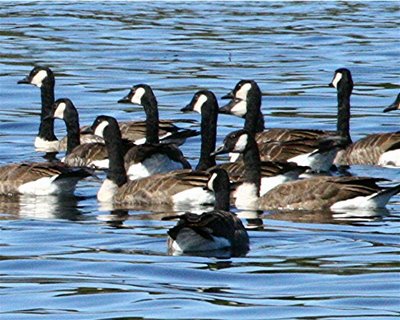



 A lot can be added to a person's knowledge of identifying character- istics of birds at their various life stages through studying details in photos. A good example of this is the comparision of details from a couple of photos that I had taken on the weekend of a 1st winter Ring-billed Gull and an adult nonbreeding Ring-billed Gull. Noting the difference in leg colour of these two gulls; the younger gull shown above has pink legs and the adult to the right has yellow ones. The ring positioning on the bill also is different. The black ring on the 1st winter gull's bill extends to the tip while the mature bird's shows the ring further up on the bill. The bill colour is different too; the younger gull's bill is pink and the adults is yellow.
A lot can be added to a person's knowledge of identifying character- istics of birds at their various life stages through studying details in photos. A good example of this is the comparision of details from a couple of photos that I had taken on the weekend of a 1st winter Ring-billed Gull and an adult nonbreeding Ring-billed Gull. Noting the difference in leg colour of these two gulls; the younger gull shown above has pink legs and the adult to the right has yellow ones. The ring positioning on the bill also is different. The black ring on the 1st winter gull's bill extends to the tip while the mature bird's shows the ring further up on the bill. The bill colour is different too; the younger gull's bill is pink and the adults is yellow.

 This is the time of year when I often check along roadside birch trees on sunny days hoping to catch a glimpse of one feeding in the trees; for that method has most often been my sighting experience. Being able to photograph this Grouse from my living room window was a pleasant surprise.
This is the time of year when I often check along roadside birch trees on sunny days hoping to catch a glimpse of one feeding in the trees; for that method has most often been my sighting experience. Being able to photograph this Grouse from my living room window was a pleasant surprise. 
 This juvenile Great Blue Heron, seen in the photo to the right, could well be my last Heron sighting this fall as the season is now getting late. I think this most recent photo of Oct. 23 creates an interesting seasonal balance with the first Heron photo
This juvenile Great Blue Heron, seen in the photo to the right, could well be my last Heron sighting this fall as the season is now getting late. I think this most recent photo of Oct. 23 creates an interesting seasonal balance with the first Heron photo  of the year that I had taken in April. In this early spring photo the Heron is flying across a drab spring landscape and in this most recent October picture the landscape is again returning to that of dormancy.
of the year that I had taken in April. In this early spring photo the Heron is flying across a drab spring landscape and in this most recent October picture the landscape is again returning to that of dormancy.
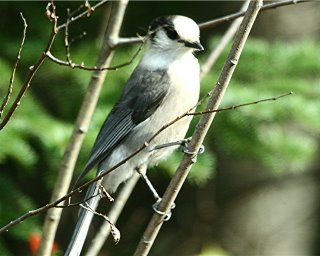 It isn't often that I see a Gray Jay (also know as as Canada Jay, Wiskey-Jack) but if I do it is usually at this time of year that I catch a glimpse of one of these coniferous forest birds.
It isn't often that I see a Gray Jay (also know as as Canada Jay, Wiskey-Jack) but if I do it is usually at this time of year that I catch a glimpse of one of these coniferous forest birds.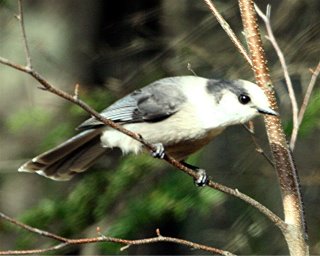 Yesterday I enjoyed that oppor- tunity. I saw it's approach through the near leafless trees alongside an old dirt road and I stopped my car and watched its
Yesterday I enjoyed that oppor- tunity. I saw it's approach through the near leafless trees alongside an old dirt road and I stopped my car and watched its 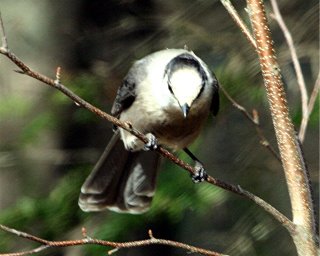 pattern of ' fly and perch' movements between the roadside branches. It would take a short flight to another tree and then briefly stop before continuing on to another.
pattern of ' fly and perch' movements between the roadside branches. It would take a short flight to another tree and then briefly stop before continuing on to another. 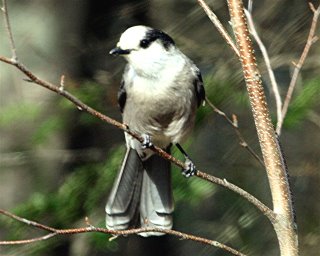 As I stood beside my car watching the Gray Jay's departing fly and perch pattern; there was a sudden gathering of Chickadees in the adjacent trees and their vibrant sounds surrounded me.
As I stood beside my car watching the Gray Jay's departing fly and perch pattern; there was a sudden gathering of Chickadees in the adjacent trees and their vibrant sounds surrounded me. 

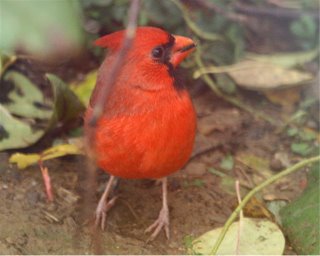 My day gets started just right if I can look out my window and see a handsome, red Northern Cardinal perched in the Choke Cheery tree overlooking our feeder area; as I did this morning. This the fourth day in a row that this beautiful male bird has put in an appearance and I'm hoping that its visits continue to be part of his daily routine.
My day gets started just right if I can look out my window and see a handsome, red Northern Cardinal perched in the Choke Cheery tree overlooking our feeder area; as I did this morning. This the fourth day in a row that this beautiful male bird has put in an appearance and I'm hoping that its visits continue to be part of his daily routine. 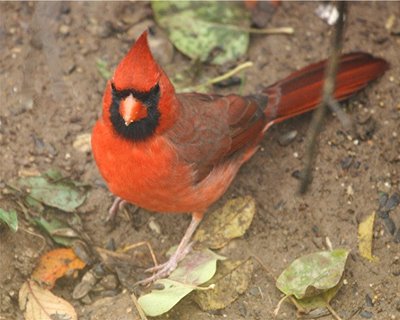


 The dark green head and white ring around its neck always made this species easily identifiable to me. However it wasn't until this spring that I was able to capture its total colourful beauty at the Sackville Waterfowl Park. A handsome male was standing on a log and then gave a full wing stretch and I was there with my camara ready!
The dark green head and white ring around its neck always made this species easily identifiable to me. However it wasn't until this spring that I was able to capture its total colourful beauty at the Sackville Waterfowl Park. A handsome male was standing on a log and then gave a full wing stretch and I was there with my camara ready! 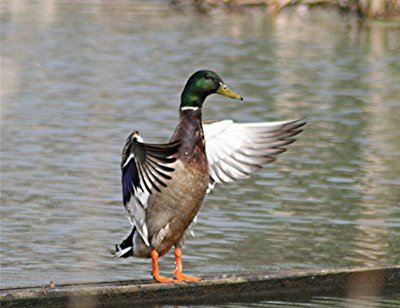
 Its always interesting to check out the birds in our feeder area this time of year for there are often returning species present that we have not seen since the winter or spring. I was very happy to see a
Its always interesting to check out the birds in our feeder area this time of year for there are often returning species present that we have not seen since the winter or spring. I was very happy to see a  White-breasted Nuthatch at one of our peanut feeders on Tuesday, Oct. 17th. These little upside down feeding birds are always a delight to watch; hopefully we shall also have a visit from a Red-breasted Nuthatch soon.
White-breasted Nuthatch at one of our peanut feeders on Tuesday, Oct. 17th. These little upside down feeding birds are always a delight to watch; hopefully we shall also have a visit from a Red-breasted Nuthatch soon.
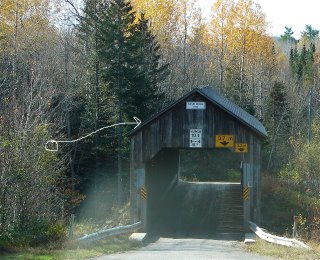 I decided to go back to the area where I had seen the bear earlier this week on the chance that I might see it again. I had no luck there but driving further on saw movements of a bird flitting back and forth between a nearyby tree and the very sunny side of a covered bridge. I assumed that maybe it was a flycatcher and parked my car near the bridge and walked closer to get a better view.
I decided to go back to the area where I had seen the bear earlier this week on the chance that I might see it again. I had no luck there but driving further on saw movements of a bird flitting back and forth between a nearyby tree and the very sunny side of a covered bridge. I assumed that maybe it was a flycatcher and parked my car near the bridge and walked closer to get a better view.  There were tufts of vegetation growth on the roof of the bridge and the bird would fly up there; most likely looking for insects. Then it would land on the vertical edge of the front of the bridge. It would sometimes fly across the road and perch on trees there and then check out the other side of the bridge. I got a hint of the identity of it when it landed in the full sun and showed me its yellow rump. Another 1st winter Yellow-rumped Warbler sighting! I have seen many this fall.
There were tufts of vegetation growth on the roof of the bridge and the bird would fly up there; most likely looking for insects. Then it would land on the vertical edge of the front of the bridge. It would sometimes fly across the road and perch on trees there and then check out the other side of the bridge. I got a hint of the identity of it when it landed in the full sun and showed me its yellow rump. Another 1st winter Yellow-rumped Warbler sighting! I have seen many this fall.

 Its getting to be that time of year that if I want to see some birds perhaps the best place to look would be in our feeder area. I saw very few birds in other places yesterday but looking out my window I saw Blue Jays, Grackles, lots of Chickadees, a couple of Goldfinch or so and one Song Sparrow. I didn't see Mourning Doves or Hairy Woodpeckers yesterday but they are usually there too. Also a Chipmunk spent a lot of time feeding and a quick scan at this posting time; I see that already the Chipmunk has arrived back this morning and one Blue Jay has returned for the day. There will be more of them later on.
Its getting to be that time of year that if I want to see some birds perhaps the best place to look would be in our feeder area. I saw very few birds in other places yesterday but looking out my window I saw Blue Jays, Grackles, lots of Chickadees, a couple of Goldfinch or so and one Song Sparrow. I didn't see Mourning Doves or Hairy Woodpeckers yesterday but they are usually there too. Also a Chipmunk spent a lot of time feeding and a quick scan at this posting time; I see that already the Chipmunk has arrived back this morning and one Blue Jay has returned for the day. There will be more of them later on.

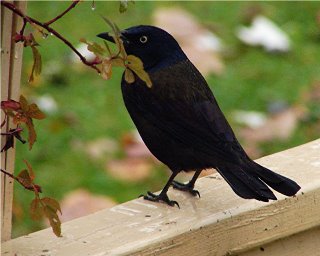
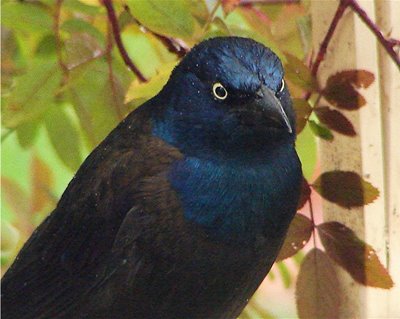

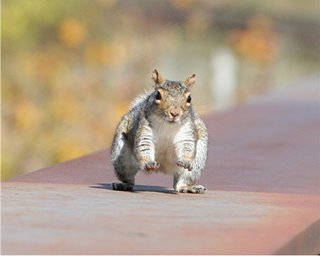 are two or three at a time. We also have Red Squirrels and Chipmunks here at times too. However this squirrel in these photos was walking along the railroad tracks and wanting to cross the railroad bridge when I came upon it last week.
are two or three at a time. We also have Red Squirrels and Chipmunks here at times too. However this squirrel in these photos was walking along the railroad tracks and wanting to cross the railroad bridge when I came upon it last week. 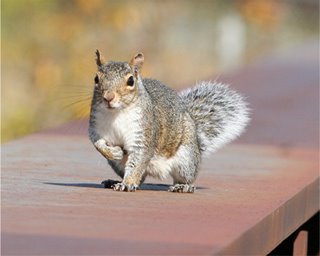 It ran along the sides of the bridge and then would hop down onto the tracks. It wanted to pass me and go to the other side but was hesitant to get too close to me. It would approach and then run back again. I moved as far away as I could and walked slowly
It ran along the sides of the bridge and then would hop down onto the tracks. It wanted to pass me and go to the other side but was hesitant to get too close to me. It would approach and then run back again. I moved as far away as I could and walked slowly 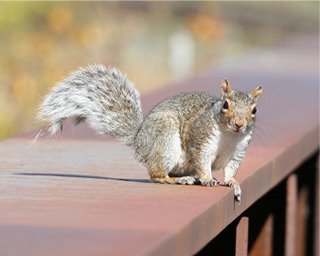 along the foot bridge. Although we were still quite close to each other the barrier between the footbridge and the railroad bridge seemed to be security enough for it and it finally made it to other side.
along the foot bridge. Although we were still quite close to each other the barrier between the footbridge and the railroad bridge seemed to be security enough for it and it finally made it to other side.

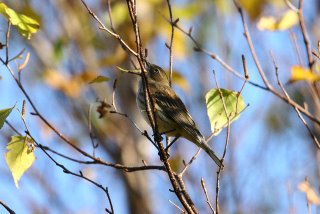

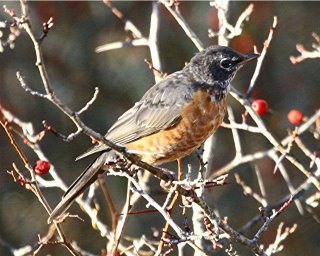
 near the end of June for the above picture of a young Robin was taken this year on June 20th. It is sometimes after that that I notice that I haven't seen a Robin for a long time. However I have started seeing them again just a day or so ago. The pictures to the above right and left were taken this morning while I was out walking. There was a fair sized flock of them and they were very active flying to and fro among the tree tops as I looked across at them from the embankment where I was standing.
near the end of June for the above picture of a young Robin was taken this year on June 20th. It is sometimes after that that I notice that I haven't seen a Robin for a long time. However I have started seeing them again just a day or so ago. The pictures to the above right and left were taken this morning while I was out walking. There was a fair sized flock of them and they were very active flying to and fro among the tree tops as I looked across at them from the embankment where I was standing.


 both the berries and the waxwings), and later on when all the best tasting berries are gone elsewhere we will see them returning to feed in our High Bush Cranberry trees.
both the berries and the waxwings), and later on when all the best tasting berries are gone elsewhere we will see them returning to feed in our High Bush Cranberry trees. 